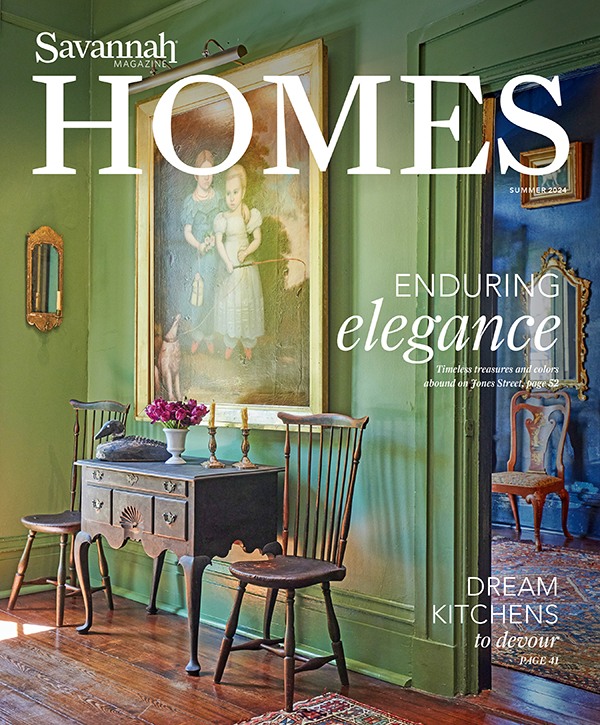
RESHMA SHAH JOHNSON / Principal architect, Shah Architecture
Describe your collaboration with these clients. What were some goals you shared?
Our firm was brought on initially to help rework the floor plan in order to create a better kitchen layout. From there, we consulted on finishes, millwork, and helped to troubleshoot some of the things that came up during construction, turning them into design opportunities. We all agreed on bringing levity to the process, and our ultimate goal was to create a home that felt fun. The clients shared our love for great materials, patterns, and textures, which turned the project into a rare and truly collaborative process.
What were some of the clients’ personal points of reference?
They love light, fresh coastal design elements, but their taste is also reflective of the western Great Plains and mountain regions, where one of them grew up—heavier, more rustic touches relating to the mountains and life out West. We knew that balancing these design opposites would be the key to creating a home that successfully reflected their personal style.

How did you decide to work in the more industrial elements, like the barn doors and the metal cording on the stair rails?
Industrial elements add a sense of history, and they visually balance organic materials like wood and natural fabrics. Because the walls of the entry foyer featured a strong wood paneling detail, we did not want to use more wood on the railings too. Metal railings helped to keep things airy but structured. In the breakfast pantry, the zinc countertops are like a utility surface—perfect for any pantry or mud room.
The bar in the elevator vestibule is a really interesting design detail. How did that come about?
The original plan had a large foyer and hallway into the great room. They also had a storage space off the elevator that they wanted to turn into a wine cellar. But cellars are storage rooms, not social spaces, and the problem with a large foyer is that no one ever goes and hangs out in a foyer—it ends up being a lot of underutilized square footage. As we redesigned the kitchen layout, I decided to make that space more special by literally opening it up to both the the foyer and the hall. By painting it a moody dark color, we instantly created an intimate pocket in an otherwise wide-open space, and now it’s the perfect overflow spot when our clients are entertaining—like being in the lobby of a hip hotel.

With its glass frontage, the indoor dining room almost feels like an outdoor room. How did that come about?
We used the same paneling and millwork detail as in the foyer, but the size of the windows keeps the space light and airy. The walls are white, and the window treatment was kept to an absolute minimum, so all the focus is on the views and splashes of color from the furniture and rugs.
This house is incredibly open, but still cozy. How did you manage that balance?
We’re obsessed with balance, so this is a huge compliment—thank you! In the great room, we used a heavy texture on the ceiling with pecky cypress and coffers to bring some some weight to an otherwise large white/breezy room. In the kitchen, we did the opposite, keeping the ceiling light to balance the heavy feel of the island and cooking hood. We believe that balance is achieved through small moves that are subtle but deliberate, not only the balance of materials and textures as described above, but also the balance of experiences. For this project, we used casual or utility surfaces next to more refined ones, and purposefully dropped ceiling heights (as in the bar hallway) and wall sconce heights—so that contrast is felt, not seen. We tried to eliminate most of the hallways so that you move through fully realized/considered spaces, not corridors. And finally, we use millwork to create coziness. Millwork gives you a traditional foundation and provides scale.
How involved were the homeowners in the design process?
They were really hands on! She has impeccable taste, and she’s very resourceful—every part of this home has her touch. It was like working with another designer, and we could really bounce ideas off each other. As a commercial developer, he’s knowledgeable about building and construction, so everyone played a role, and we all had a lot of trust in each other. Over the course of the project, they found out they were pregnant with their first child, which made the process even more meaningful.

From your perspective, what makes this house a home?
We tried to select finishes that stirred an emotion, rather than playing it safe. These “living finishes” help to create a sense of ease, so you don’t feel like you are living in a museum or model home. The homeowners took time to select things that told a story or reminded them of their family and their travels. Finally, we think the most important thing that makes this house a home is the fact that every space is used, and some spaces even have multiple uses. When people truly live in every room at some point in the day, the house feels familiar in all corners.
CURRY SALANDI / Principal Designer, Curry & Company
Designing and decorating a new build requires such a specific kind of vision. What were some keywords or points of reference your clients gave you for this project?
A sweet young family that wanted to create a kid-friendly welcoming home with their unique style. The interiors are grand in scale, but not overdone. When we started working together, the different materials and trim work already stood out as defining element of this house. One of my first recommendations was purely practical: I suggested adding a door off the master closet into the laundry room.

This is hands-down the most gorgeous laundry room I’ve ever seen. Talk to me about how it came together.
The laundry room is my favorite room in the house. As we flipped through wallpaper memo samples, the client fell in love with the whimsical bird pattern motif and the rest of the design came together from there. I like using wallpaper in small spaces like accent walls and ceilings, to add visual interest without overwhelming the room.
The base materials of this home—cerused finishes, pecky cyprus, shiplap—feel so considered and intentional. How did you go about choosing them?
To me, millwork in a home always is a good idea, and [architect] Reshma Johnson is truly amazing at her craft. We collaborated on this project and everyone was so happy with how it turned out.

How did you work your clients’ family pieces into the mix while still adhering to your design vision?
Updating family heirlooms with paint and glaze (as we did in the guest bedroom) gives new life to pieces with sentimental value, while allowing them to seamlessly integrate into the eclectic style of the home.
Is color a signature of yours, or did it just particularly suit these clients?
I always try to integrate color in my design to add depth and personality to a space. It also fit the bill for this home, where we were trying to make beautiful rooms that were still design-minded but still able to withstand the demands of a growing family.


Let’s talk about that nursery.
It’s such a fun and welcoming atmosphere, but it also blends nicely with the rest of the home. This little girl is about to join a loving and creative family, and I think her room shows that.


